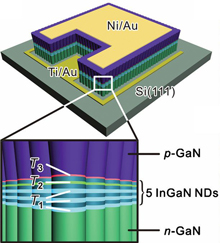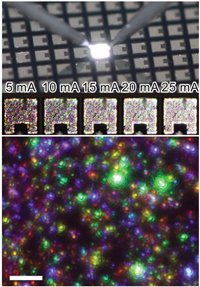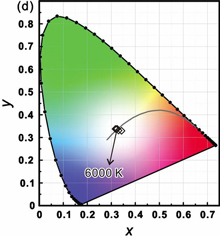
| Home | About Us | Contribute | Bookstore | Advertising | Subscribe for Free NOW! |
| News Archive | Features | Events | Recruitment | Directory |
News
20 August 2010
Taiwan researchers show nanorod route to white LEDs
Taiwan National Tsing-Hua University researchers believe that they have found a “unique possibility to fabricate nanorod array LEDs with high color rendering capability” [Hon-Way Lin et al, Appl. Phys. Lett., vol97, p073101, 2010].
Rather than using planar multi-quantum well (MQW) indium gallium nitride (InGaN) light-emitting devices, the Taiwan group is developing vertical, self-aligned, catalyst-free gallium nitride (GaN) nanorod arrays grown on 3-inch n-type silicon (111) substrates. The researchers grew their nanorod arrays using plasma-assisted molecular beam expitaxy (PAMBE).
The nanorods are used as “nanostructured compliant templates for growing strain-free InGaN nanodisks”. The strain-free nature arises because the nanodisks can be grown thicker (tens of nanometers) than usual planar MQW InGaN layers (2–4nm). When LEDs based on InGaN nanodisks are produced there is a spread in emission wavelengths, with the peak depending on the growth temperature and In/Ga beam fluxes.
Although there has been recent work that has enabled the whole range of InGaN compositions (In 0–100%) to be produced on nanorods (resulting in blue to red LEDs), until now white light has not been achieved due to difficulties in arranging appropriate light-mixing conditions.

Figure 1: Schematic of nanorod-array LED structure for generation of white light. Active regions contain multiple InGaN nanodisks.
The new approach is to stack nanodisks with different emitting properties to achieve appropriate mixing to obtain white light (Figure 1). Because of the strain-free nature of the nanodisks, the researchers are not limited to the active-layer thicknesses of a few nanometers common for normal planar MQW designs. Instead, the nanodisk active layers can be in the range 10–25nm. The thick disks also reduce another planar MQW defect – carrier overspill into the contacts, most usually electrons recombining in the p-contact, reducing light-emission efficiency.

Figure 2: (Top) Photo of nanorod-array LED emitting white light at 20mA injection current. Micro-EL images below are acquired under a 10x objective lens at various injection currents. (Bottom) Micro-EL image (20mA) under 100x objective lens revealing full-visible-spectrum emissions from white LED. Scale bar: 10μm.
At the present proof-of-concept stage, the emissions from the arrays are ‘spotty’ (Figure 2). Even so, there are localized full-color emissions from the array. The researchers believe this demonstrates the “unique possibility to fabricate nanorod array LEDs with high color rendering capability”.
For planar white LEDs, one generally uses an ultraviolet (UV) or blue LED combined with a phosphor emitter to produce a broad range of wavelengths of light. One reason for using this inefficient arrangement is the difficulty in filling the green–yellow gap with efficient direct light-emitting devices. To obtain high color rendering indices (CRIs) with normal UV/blue LEDs requires a wide array of phosphors with appropriate temperature stability, quantum efficiency, and chemical robustness.
The nanorod LEDs were tested over the injection current range 5–25mA and showed “negligibly small spectral blue-shifts” in emission with increasing current. The spectral analysis revealed that the ensemble of emitters contained major peaks at blue and yellow wavelengths, with a third weaker ensemble contribution extending into red wavelengths. The electroluminescence depends in a linear fashion on the injection current.
 Figure 3: Commission internationale de l’éclairage 1931 chromaticity coordinates at injection currents from 5mA to 25mA. The correlated Planckian color temperature stays near 6000K (natural white light) for injection currents larger than 5mA.
Figure 3: Commission internationale de l’éclairage 1931 chromaticity coordinates at injection currents from 5mA to 25mA. The correlated Planckian color temperature stays near 6000K (natural white light) for injection currents larger than 5mA.
The blue-shift for the blue light is 1.3nm, and for the yellow it is 2.4nm (normal green LEDs can show shifts of tens of nanometers). The researchers believe that the small shifts seen in their nanorod devices may be due to small spontaneous polarization mismatches between the InGaN and GaN materials. The correlated color Planckian temperature remains near 6000K (natural white light) for injection currents larger than 5mA (Figure 3).
![]() Search: White LEDs GaN
Search: White LEDs GaN
Visit: http://apl.aip.org
Visit: www.phys.nthu.edu.tw/en
The author Mike Cooke is a freelance technology journalist who has worked in the semiconductor and advanced technology sectors since 1997.